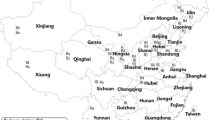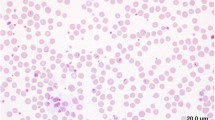Abstract
Serological comparisons among piroplasm antigens of the benignTheileria species of cattle from Japan, Australia and Britain, which are frequently referred to asT. sergenti, T. buffeli andT. orientalis, were carried out. The results obtained from comparative enzyme-linked immunosorbent assay (ELISA) using sera from infected cattle suggest thatT. sergenti could be differentiated from bothT. buffeli andT. orientalis by their serological dissimilarities. Western blotting combined with two-dimensional polyacrylamide gel electrophoresis (2D-PAGE) revealed that both the 33-kDa piroplasm protein ofT. sergenti and the similar 34-kDa protein ofT. buffeli andT. orientalis corresponded to immunodominant antigens against cattle. The other 32-kDa proteins ofT. buffeli andT. orientalis also represented immunodominant antigens. Cross-reactivities of the 32-and 34-kDa proteins were observed betweenT. buffeli andT. orientalis, whereas the 33-kDa protein ofT. sergenti could be differentiated from the similar 34-kDa proteins ofT. buffeli/orientalis. The present study suggests thatT. sergenti should be separated fromT. buffeli andT. orientalis on the basis of their serological dissimilarities.
Similar content being viewed by others
References
Asao T, Kinoshita Y, Kozaki S, Uemura T, Sakaguchi G (1984) Purification and some properties ofAeromonas hydrophila hemolysin. Infect Immun 46:122–127
Callow LL (1984) Theileriosis. In: Callow LL (ed) Animal health in Australia, vol 5. Australian Government Publishing Service, Canberra, pp 168–173
Dunn SD (1986) Effects of the modification of transfer buffer composition and denaturation of proteins in gels on the recognition of proteins of Western blots by monoclonal antibodies. Anal Biochem 157:144–153
Fujisaki K, Ito Y, Kamio T, Kitaoka S (1985) The presence ofTheileria sergenti inHaemaphysalis longicornis overwintering in pasture in Japan. Ann Trop Med Parasitol 79:519–524
Fujisaki K, Kamio T, Kawazu S (1991a)Theileria sergenti cannot be regarded as the same species asT. buffeli andT. orientalis because of its transmissibility only byKaiseriana ticks. In: Dusbabek F (ed) Modern acarology, vol 1. Publishing House Academic, Prague (in press)
Fujisaki K, Kawazu S, Kamio T, Stewart NP (1991b) Experimental transmission of JapaneseTheileria sergenti and AustralianT. buffeli by haemaphysaline tick species. In: Dusbabek F (ed) Modern acarology, vol 2. Publishing House Academia, Prague (in press)
Glascodine J, Tetley L, Tait A, Brown D, Shields B (1990) Developmental expression ofTheileria annulata merozoite surface antigen. Mol Biochem Parasitol 40:105–112
Hurley WL, Finkelstein E, Holst BD (1985) Identification of surface proteins on bovine leukocytes by biotin-avidin protein blotting technique. J Immunol Methods 85:195–202
Katende JM, Goddeeris BM, Morzaria SP, Nkonge CG, Musoke AJ (1990) Identification of aTheileria mutans-specific antigen for use in an antibody and antigen detection ELISA. Parasite Immunol 12:419–433
Laemmli UK (1970) Cleavage of structural proteins during the assembly of the head of bacteriophage T4. Nature 227:680–685
Morzaria SP, Barnett SF, Brocklesby DW (1974) Isolation ofTheileria mutans from cattle in Essex. Vet Rec 94:256
O'Farrell PZ, Goodman HM, O'Farrell PH (1977) High resolution two-dimensional electrophoresis of basic as well as acidic proteins. Cell 12:1133–1142
Shimizu S, Suzuki K, Nakamura K, Kadota K, Fujisaki K, Ito S, Minami T (1988) Isolation ofTheileria sergenti piroplasms from infected erythrocytes and development of an enzyme-linked immunosorbent assay for serodiagnosis ofT. sergenti infections. Res Vet Sci 45:206–212
Stewart NP, DeVos AJ, Shiels JA, McGregor W (1987a) The experimental transmisson ofTheileria buffeli of cattle in Australia byHaemaphysalis humerosa. Aust Vet J 64:81–83
Stewart NP, DeVos AJ, McGregor W, Shiels IA (1987b)Haemaphysalis humerosa, notH. longicornis, is the likely vector ofTheileria buffeli in Australia. Aust Vet J 64:280–282
Sugimoto C, Sato M, Kawazu S, Kamio T, Fujisaki K (1991a) Purification of merozoites ofTheileria sergenti from infected bovine erythrocytes. Parasitol Res 77:129–131
Sugimoto C, Kawazu S, Kamio T, Fujisaki K (1991b) Protein analysis ofTheileria sergenti/buffeli/orientalis piroplasms by two-dimensional polyacrylamide gel electrophoresis. Parasitol 102:341–346
Uilenberg G, Perie NM, Spanjer AAM, Franssen FFJ (1985)Theileria orientalis, a cosmopolitan blood parasite of cattle: demonstration of the schizont stage. Res Vet Sci 38:352–357
Yakimoff WL, Dekhtereff NA (1930) Zur Frage über die Theileriose in Ostsibirien. Arch Protistenkd 72:176–189
Author information
Authors and Affiliations
Rights and permissions
About this article
Cite this article
Kawazu, S., Sugimoto, C., Kamio, T. et al. Antigenic differences between JapaneseTheileria sergenti and other benignTheileria species of cattle from Australia (T. buffeli) and Britain (T. orientalis). Parasitol Res 78, 130–135 (1992). https://doi.org/10.1007/BF00931654
Accepted:
Issue Date:
DOI: https://doi.org/10.1007/BF00931654




